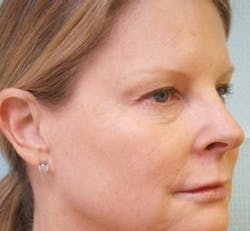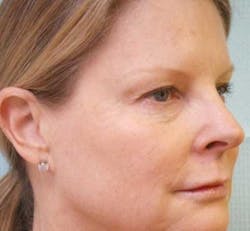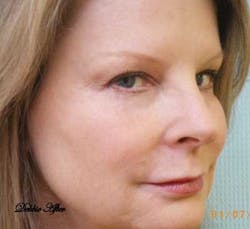The next revolution in dentistry: facial injectables
By Bruce G. Freund, DDSThis is a very exciting time for dentists. Dentistry has taken on a new dimension, giving dentists a new arena in which to practice their artistic talents and increase their income stream. There has been no advancement in the last 25 years — whether it be laminates, implants, lasers, bleaching, CEREC, or digital X-rays — that even comes close to what facial injectables can do for the dentist economically. Unlike facial injectables, all of the other dental advancements require costly investments. For the dental practitioner, the beauty of becoming a facial injector means there is no involvement with insurance companies or laboratories, no accounts receivable (no billing, no external advertising) because your new patients are your existing patients, and — best of all — there is no expensive equipment to buy or lease. Now, what exactly are facial injectables? Basically there are two kinds of injectables: neurotoxins and dermal fillers. BOTOX® and Dysport® are neurotoxins that are used to relax muscles; in doing so, they smoothe out wrinkles. BOTOX is actually Botulinum Toxin A and has been approved since 2002 for nonsurgical esthetic treatments. Dysport, its competitor, has been used in Europe for many years but has recently been approved by the FDA for use in the United States. The basic placement of BOTOX/Dysport would be in the upper third of the face, meaning the forehead, between the eyes, and around the eyes. The results of a BOTOX/Dysport treatment are not seen immediately. With BOTOX, it can take up to 14 days for results to appear, while Dysport seems to have the ability to produce results more quickly. Dermal fillers are used to fill in wrinkles and folds. They do so by actually filling in a void in the skin. There are basically two types of dermal fillers that are popular today. The first is a non-animal stabilized hyaluronic acid, which is a clear gel. This type of dermal filler is injected into the mid-dermis of the skin. The names of the products that fall into this category are Restylane®, Perlane®, and Juvéderm™. The second type is a calcium hydroxylapatite that is white in color and similar to the substance found in the teeth and bones. It is injected into the deeper dermis. The name of the material that falls into this category is Radiesse®. The purpose of all these dermal fillers is to provide volume and pliability to the skin.
Before
AfterWhy are dentists the best choice of all health-care professionals as facial injectors? Simple — of all health-care professionals, no one is better trained in injection techniques. As part of our dental training, we were taught — that’s right, taught — to inject. Who is better trained at giving pain-free injections? Who knows better the shape and volumetric proportions of the facial structures? Who knows better the anatomy, blood vessels, muscles, bones, nerves of the face, etc.? Who better understands the relationship of the anatomic structures — the eyes, cheeks, nose, lips, teeth, etc. — and more importantly, how they relate esthetically to one another? In addition to having the skill, no other health-care professional gives as many injections in the facial area on a daily basis as a dentist. This is what a dentist does day in and day out. When dentists go into an operatory to perform a procedure such as a crown preparation or implant surgery, they don’t realize it but they are actually performing two procedures: They are the anesthesiologist and the dentist. They are unaware that they have performed an entire second procedure, because they do it so automatically. They give this anesthesia profoundly and relatively painlessly. They do this so routinely and so well that they are not even cognizant of how good they are with a needle. Their patients know how good they are and they have less fear and more confidence in their own dentist approaching their face with a needle than they would with any other health professional. The reason a dentist would be the patient’s first choice when deciding to have facial cosmetic injectables is that dentists can offer their patients something most other health-care professionals cannot — dental anesthetic to reduce discomfort during the procedure. Most practitioners are not comfortable injecting intraorally and will only give patients a topical anesthetic. For us dentists, injecting intraorallly is second nature. In training health-care providers to inject, one of the things they most frequently ask me is how to give a dental block so that patients do not feel any pain. As you become a more advanced injector, I can train you, as I have trained others, to place many of the facial fillers intraorally using a specialized technique that further reduces pain and virtually eliminates swelling and bruising. Again, it is of little wonder to me why anyone would question the fact that dentists should be the primary “go-to” for facial cosmetic injectables.Now, let’s talk economics. Imagine earning $1,000 per hour net as a beginner injector, and then imagine earning $2,000 per hour net as an experienced injector. With facial injectables, you can have a source of income in which there is no billing, no accounts receivable, no insurance companies, and no laboratories to deal with. Patients pay for the service they just received, in full, prior to leaving your office. To help you understand the magnitude the addition of facial injectables can make to your economic growth, let’s look at some actual procedures and numbers. An average patient will require three areas of BOTOX/Dysport in the upper third portion of the face and two syringes of filler, one in each of the nasolabial folds. Based on an average product cost factor of $250 for the Botox for these three areas and a procedure cost of $700, and a cost factor of $250 per syringe for filler and a procedure cost of $600/syringe, a net profit of $1,150 will result (total product cost was $750; total procedure cost was $1,900). These procedures should take a beginner injector approximately one hour to complete. An experienced injector could complete these procedures in half an hour.
Injection in the nasolabial foldsNow, let’s expand these numbers using a minimum net profit margin of $1,000. One patient per day times five days is $5,000 per week times 50 weeks equals a net profit of $250,000 per year. Now, just imagine, two patients a day. A dentist can realistically increase his or her income by $500,000 dollars per year. For many dentists, that might actually be more than they earn from their entire dental practice. In dentistry, our goal as dental professionals is always the long-term result. We want our dental procedures to be of a long-lasting quality. Adversely, in facial injectables and with the products I have just discussed, there is no long-term result. BOTOX/Dysport lasts anywhere from three to six months. The facial fillers, depending on which filler is used, can last from three to 18 months. Each individual patient is different, as well as the fact that each product is different. This gives the dentist a built-in annuity. Your patients are happy to return, time and time again, to look younger and feel good about themselves. It is a source of extreme satisfaction for both the dentist and the patient. How can you get involved in facial injectables? It was my patients who convinced me, and I want to convince you. Any dentist who has the ability to place laminates or implants has the ability to inject neurotoxins and dermal fillers. I have taught hundreds of health-care professionals in these techniques and have found dentists to be, beyond a shadow of a doubt, the best injectors. Along with three colleagues, I founded the American Academy of Facial Cosmetics (AAFC), and it is our goal to enlighten and train dentists throughout the country in cosmetic facial injectables. The AAFC offers a two-day, hands-on course. At the end of the course, I guarantee that you will be a facial injector. You will be given the knowledge and the techniques you need to make this new skill a formidable part of your dental practice. This course is the only investment you need to get started.In today’s economy, dentists, like most businesspeople, need to find other outlets for producing additional income. Our backs and hands can only work a certain amount of years before we are forced by nature to slow down. Here is our golden opportunity. Dentists need to realize that it is important to continually strive keep current and “keep it fresh” in order to provide patients with the most up-to-date technology. We are the most logical choice to perform facial procedures that combine physiologic knowledge with artistic skills. Now we have the chance not only to increase our income, but to give ourselves something new to be passionate about. It is a win-win for both our patients and us.
Bruce G. Freund, DDS, is a founding member and CEO of the American Academy of Facial Cosmetics and one of the few certified facial injector trainers for Allergan, makers of BOTOX and Juvéderm, and for Medicis, makers of Dysport, Restylane, and Perlane. For more information on how to become a facial injector, you can contact Dr. Freund at (201) 568-0606 or www.drbrucefreund.com. To find out more information about the American Academy of Facial Cosmetics, visit www.aafcinjectables.org.




